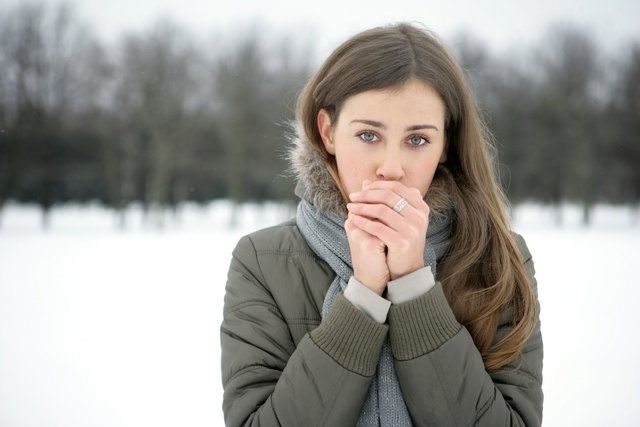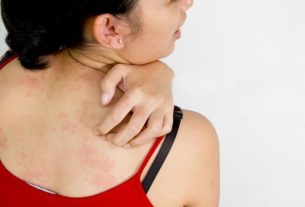Cold allergy is a popular term for cold urticaria and consists of an allergic reaction due to exposure to low temperatures, causing symptoms such as raised, red patches on the skin and itching, redness and/or swelling in parts of the body.
This type of allergy is caused by exposure to cold, due to contact with cold air or objects or consumption of cold drinks, for example, and is more common in young women with a history of allergies.
If you suspect an allergy to cold, it is recommended to consult a dermatologist or allergist. Treatment usually involves avoiding exposure to low temperatures, and the use of anti-allergy medications may also sometimes be indicated.

Cold allergy symptoms
The main symptoms of cold allergy are:
- Red, raised spots on the skin;
- Itching, swelling and/or redness in parts of the body;
- Burning sensation in the skin;
- Tiredness;
- Abdominal pain, nausea and/or diarrhea, in some cases.
Symptoms of cold allergy tend to appear around 5 to 10 minutes after skin contact with water, objects or cold wind and normally improve within 1 hour spontaneously, and it is common to affect the most exposed parts of the body.
However, especially in cases where the body area exposed to cold is large, the risk of serious allergic reactions such as anaphylaxis is greater. In this case, symptoms such as low blood pressure, fainting or difficulty breathing may appear, putting the person’s life at risk.
Read too: Anaphylaxis: what it is, symptoms, causes and treatment
Online symptom test
To find out the chances of having an allergy, please indicate the symptoms you present below:
This test is a tool that only serves as a means of guidance and, therefore, is not intended to provide a diagnosis or replace consultation with an allergist, immunologist or general practitioner.
How to confirm the diagnosis
The diagnosis of cold allergy is made by a dermatologist or allergist taking into account the symptoms, health history and changes observed when examining the skin when exposed to the cold.
Your doctor can test for sensitivity to cold by placing an ice cube in contact with the skin on your forearm for about 5 minutes and checking for symptoms, which usually occur within 10 to 30 minutes of removing the ice.
If you want to schedule an appointment, find a dermatologist closest to you using the tool below:
Taking care of your health has never been easier!
In some cases, the doctor may recommend blood tests to rule out other diseases, such as viral infections and immunological changes, which may be associated with the development of cold allergy.
What is the difference between cold allergy and perniosis?
Cold allergy can affect the skin on any part of the body that has been exposed to low temperatures and, typically, symptoms appear minutes after exposure to cold due to an allergic reaction that causes the release of inflammatory substances.
Perniosis, also known as erythema pernio, is associated with constant or prolonged exposure to cold and humid environments and is believed to be caused by a narrowing of blood vessels, especially affecting the extremities of the body, such as the fingers and/or fingers. or feet.
Possible causes
Cold allergy is believed to be caused by the body’s reaction to low temperatures, resulting in the release of inflammatory substances, such as histamine, interleukins and leukotrienes.
Furthermore, cold allergy is more common in young women with a history of asthma, allergic rhinitis and/or other allergies and in case of a family history of cold allergy, viral infections such as mononucleosis, hepatitis or HIV, and diseases that affect the immune system, for example.
How the treatment is carried out
The treatment of cold allergy must be guided by a dermatologist or allergist and can be done with:
1. Avoid exposure to cold
The most important measure in treating cold allergy is avoiding exposure to low temperatures, which may involve avoiding contact with cold objects, air or water, not consuming cold foods or drinks and dressing appropriately.
Especially for people who live in regions with low temperatures or work or travel to cold places, it is important to keep the body warm by wearing warm clothing such as gloves, boots, hats and socks.
2. Use of antihistamines
Antihistamines, such as loratadine, desloratadine, fexofenadine or cetirizine, may be prescribed by your doctor to alleviate cold allergy symptoms.
Furthermore, when cold allergy is associated with other diseases, it is important that your treatment is carried out in accordance with your doctor’s instructions to help control the allergy.
3. Adrenaline Pen
In more serious cases, the symptoms can put the person’s life at risk, the doctor may recommend the use of an adrenaline pen (epinephrine), which can be used as soon as the symptoms appear to reverse them.
Read too: Epinephrine: what it is for, how to apply it and side effects
In addition, adrenaline in injection form is also used in hospitals with medical indication in case of severe allergic reactions caused by cold allergy.
Possible complications
The main complication of cold allergy is anaphylactic shock, which can be identified through symptoms such as difficulty breathing, low blood pressure, a feeling of a closed throat, swelling in the mouth, tongue or face and loss of consciousness.
This type of reaction is serious and can be life-threatening. Therefore, in these cases, medical attention should be sought immediately. See what first aid should be like for anaphylactic shock.

Sign up for our newsletter and stay up to date with exclusive news
that can transform your routine!
Warning: Undefined array key "title" in /home/storelat/public_html/wp-content/plugins/link-whisper-premium/templates/frontend/related-posts.php on line 12
Warning: Undefined array key "title_tag" in /home/storelat/public_html/wp-content/plugins/link-whisper-premium/templates/frontend/related-posts.php on line 13



